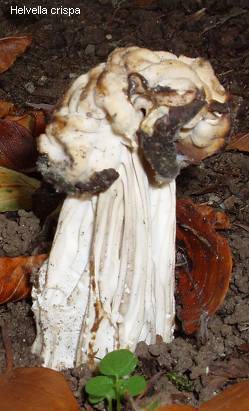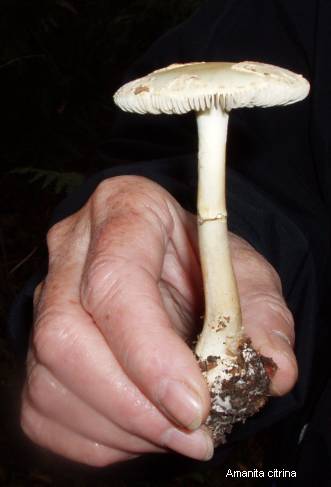
Back to the Index page

Ten members and guests met at Wykeham North Moor for our last outdoor meeting of the year, in rather gloomy, damp conditions. Sadly the weather up until now had been relatively dry, so there were not many fungi in evidence – and some of those we did see were rather dried up; also the slugs seemed to have been having a field day, and many specimens were badly damaged, in some cases hollowed out completely. We still recorded over 50 species (list below).
We met north of Wykeham village at the edge of the forestry, and welcomed our leaders Colin and Beryl Stephenson. Colin has been leading our fungus forays for many years and it is always a pleasure to see him and learn from his expertise. This is mostly an area of old moorland which has been afforested since the 1930s. The soil is generally poor and acid with some peat, so vegetation under the trees is mainly of heathers, bilberry and mosses. It has a rich fungal flora because of the trees, since many fungi grow in association with both coniferous and deciduous trees, especially on the roots, dead wood, leaf litter etc.
Colin first of all introduced us to the kingdom of Fungi, one of the principal divisions of life on a par with Animals and Plants. They are a fascinating group, living either as parasites or saprophytes, gaining their nourishment from living or dead matter respectively. The brackets or mushrooms/toadstools that we see are merely the spore-bearing “fruits” of the organism. The rest of the fungus exists as a mesh of threads or mycelium in the soil or other substrate such as bark or wood. Colin wisely stressed that some fungi are poisonous in varying degrees, that you should never eat any unfamiliar species, and that after a foray such as this you should wash your hands.
We then investigated the grassland around the car park, and under the trees, where we found several different kinds of fungi, including traditional toadstools or cap fungi, rusts and mildews on plants, and a representative of the cup fungi, Helvella crispa (see left). Colin memorably described this as reminding him of “A stick of celery with a saddle on top.” Just so. Colin showed us many different kinds of toadstool, explaining some of the tricks of the ID game: for example, one of the milk-caps that grows under birches produces a milky juice that turns yellow when dripped onto a clean white hanky. However, he did admit that fungi can be very difficult to identify down to species level, and in many cases one must use a microscope and/or various chemicals – he took several specimens home to his lab to determine. Some groups are apparently more difficult than others, with the Cortinarias being hard even for specialist mycologists – the rest of us would be delighted if we even got close to the genus!

The rest of the walk was in the forest, under both conifers and broadleaved trees, as these tend to have different fungal associates. Indeed, to be a competent mycologist you also need to be a good botanist, as recognising the host species is an important step in tracking down your fungus. For example the Amanita citrina shown right associates with beech and oak (I believe this specimen was under oak). Of course, it isn’t always that easy: for example we kept seeing specimens of one fungus that grows on dead wood on what seemed to be leaf litter – because the dead wood was buried a few inches below the surface...
We also saw bracket fungi and three different puffballs, showing the great variety of forms that fungal fruiting bodies can take. At last, as we returned to the car park we saw the archetypal pixie toadstool – the red-with-white-spots fly agaric Amanita muscaria that grows on tree-roots, usually birch. It’s a pity that such a beautiful thing should be poisonous!
At the end of the meeting Tom Denney thanked Colin and Beryl on behalf of the Ryedale Natural History Society for leading the excursion and teaching us so much.
Gill Smith, October 2005.
Photos by Rhona Sutherland.
Back to the Top
Many thanks to Colin and Beryl for the list.
| ASCOMYCOTINA | |
PYRENOMYCETES AND PLECTOMYCETES |
|
| Erysiphe heraclei | on H.sphondylium and A.sylvestris leaves |
| Hypoxylon multiforme | on fallen Betula |
| Microsphaera alphitoides | on Quercus leaves |
| Xylaria hypoxylon | on fallen Betula |
| Sphaerotheca epilobii | on E.montanum |
| Kretzschmaria deusta | on old Fagus stump |
DISCOMYCETES |
|
| Helvella crispa | in grass with Fagus |
| Rhytisma acerinum | Acer leaves |
LOCULOMYCETES |
|
| Rhopographus filicinus | on Pteridium |
| BASIDIOMYCOTINA | |
HYMENOMYCETES |
|
| Amanita citrina | with Fagus |
| Amanita citrina var alba | with Fagus |
| Amanita muscaria | with Pteridium and Abies |
| Amanita rubescens | with Picea |
| Boletus chrysenteron | with Quercus |
| Chalciporus piperatus | with A.muscaria |
| Clitocybe clavipes | with Quercus |
| Clitocybe gibba | with Fagus |
| Clitocybe nebularis | with Picea and Pinus |
| Clitopilus prunulus | ride side |
| Collybia butyracea | with Fagus and Picea |
| Collybia confluens | with Fagus |
| Collybia peronata | with Fagus |
| Cortinarius anomalus | with conifer |
| Cortinarius semisanguineus | with Calluna vulgaris |
| Entoloma conferendum | on mossy lawn |
| Gymnopilus penetrans | on fallen Pinus |
| Hypholoma fasciculare | on deciduous stump |
| Inocybe eutheles | with Picea |
| Inocybe geophylla | with Fagus |
| Inocybe pudica | with conifer |
| Laccaria amethystina | with Fagus |
| Laccaria laccata | with Fagus |
| Laccaria proxima | with Pteridium |
| Lactarius blennius | with Fagus |
| Lactarius fluens | with Fagus |
| Lactarius quietus | with Quercus |
| Lactarius subdulcis | with Fagus |
| Lactarius tabidus | with Betula |
| Lepista inversa | with Picea |
| Mycena amicta | with conifer |
| Mycena flavoalba | on fallen Salix lvs in grass |
| Mycena pura | with Fagus |
| Russula cyanoxantha | with Quercus |
| Russula fellea | with Fagus |
| Russula mairei | with Fagus |
| Russula nigricans | with Quercus |
| Russula ochroleuca | with Fagus |
APHYLLOPHORALE TYPE FUNGI |
|
| Clavulina rugosa | in lawn |
| Ganoderma applanatum | on Fagus stump |
| Piptoporus betulinus | on Betula |
| Skeletocutis amorpha | on old conifer logs |
| Trametes versicolor | on old deciduous stump |
| Trichaptum abietinum | on Pinus stump |
HETEROBASIDIOMYCETES |
|
| Calocera pallidospathulata | on fallen conifer |
| Dacrymyces stillatus | on fallen conifer |
GASTEROMYCETES |
|
| Handkea excipuliformis | with conifer |
| Lycoperdon nigrescens | with Picea |
| Lycoperdon perlatum | with conifer |
UREDINOMYCETES |
|
| Melampsoridium betulinum | on Betula leaves |
| Phragmidium violaceum | on Rubus leaves |
Colin R Stephenson
Recorder for Mycology
Scarborough Field Naturalists’ Society
Back to the Top
Back to the Index page
© Ryedale Natural History Society 2005, photos © Rhona Sutherland 2005
Page last modified 23rd October 2005. Site maintained by APL-385